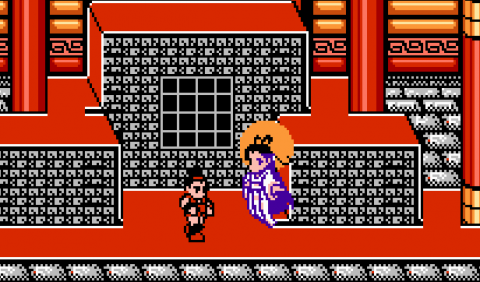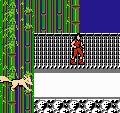Conquest of the Crystal Palace was developed and published by Quest in Japan, and released by Asmik in the US. It was one of Quest’s first titles, and the company would later become famous for the Ogre Battle series before being bought and merged into Squaresoft. It also started the careers of Yasumi Matsuno, the brilliant writer/designer, and Masaharu Iwata, the famed composer. Together with Matsuno, the two’s paths would be linked as they collaborated on many other classics throughout the years.
The game starts out innocently enough with a boy named Farron and a dog named Zap running together and having a grand old time. However, Zap is no ordinary dog, but a talking canine who reveals Farron’s true identity to him. It turns out Farron is a prince whose kingdom was conquered by the evil Zaras and now that Farron is of age, the time has come for him to take back what is rightfully his, the Crystal Palace.
After this brief intro, it’s time to choose a crystal that will grant you a special ability. Among these are the Life Crystal which increases your health, the Flight Crystal which increases your jumping ability, and the Spirit Crystal which gives you the ability to shoot fireballs. The default is the Life Crystal, but probably the best one to pick is the Spirit Crystal. Ultimately it doesn’t make much of a difference which one you choose because you can just buy the other two in the form of items later on.
Much of the game is typical of side-scrolling action platformers, but the controls are solid, and it’s challenging without being too frustrating. The only major control issue is that attacking in mid-air will cut your jump short, which feels awkward at first but can be adjusted to. The stages are all fairly linear, but some of them have their own quirks and secrets to them. Most notably, the second stage contains a secret area that is accessed by falling into a pit. It’s very easy to miss and you are immediately faced with a mini-boss, but if you win you’re rewarded with a powerful weapon.You also have a variety of weapons and abilities at your disposal, the most useful being your dog Zap. Taking a note from Sega’s Shadow Dancer, whenever any enemies are around and Zap is active, he will immediately attack them until they are dead. If you have the dog whistle, you can even initiate a super attack of sorts whereupon Zap will start spinning around and charge through any enemies in his path. However, Zap has a life meter just like Farron and needs to be fed whenever his health is running low or else he’ll die. At least he’s invulnerable to falling down pits, as he’ll just climb right up.
Rounding out the other attacks are various projectiles. You start off with a basic fireball, but there are a multitude of other variations, including the “nuker” which is a rolling fireball, the “double death”, which is a fireball that splits in two, the “boomerang annihilator”, which is a fireball that functions like a boomerang, and finally the “fuego”, which is basically a shuriken. The usage of these projectiles is very similar to Ninja Gaiden. There is also the Moon Mirror which instantly kills all enemies on screen, but can only be used once per stage. Fallen enemies are likely to drop various things like extra health, a power upgrade which lets you shoot wavebeams from your sword, and, most commonly, money which can be spent at the stores scattered about.
Throughout the course of the game, you will encounter Kim’s Astral Mart, where you can buy various items and weapons. However, Kim runs an interesting business and she’s a bit of a quirky character. If you buy enough items, Kim will literally fall in love with you and will give you a 50% discount next time you see her. On the flipside, if you continually try to buy something you can’t afford, Kim will flip out and throw you out of the shop. Every once in a while Kim will offer special weapons with a unique function, and the game will scroll to another screen where she explains everything. Finally, when you browse through enough items the first time you meet Kim each stage, she will ask you if you want to see the news. It’ll then scroll to a screen where Kim is reporting for “QNN”, a fake news station obviously based on CNN, keeping you updated on the story. Kim’s multi-faceted role is one of the better aspects of the game and helps add a certain charm.
The soundtrack is very solid and features a wide variety of catchy tunes that match the mood of the game, with one of the highlights is downright sad and creepy theme for the demented third stage full of hungry ghosts. But the real highlight of the game is its graphic design, heavily influenced by Asian history and culture, which is also brighter and cutesier than similar games like Ninja Gaiden or Batman. While there are only five stages, plenty of attention to detail has been paid that make each stage unique and beautiful. The first stage is a mountain range featuring statues carved into the mountainside, and it has a time cycle where blue skies turn into twinkling stars.
Perhaps the most unforgettable stage is the third one. Featuring an organic squirming mass in the foreground and unsettling demonic heads that seem to cry out in insatiable hunger. Despite all that, this stage was significantly toned down for its North American release, and along with a few other things there are several notable differences between the American and Japanese releases.
The squirming foreground originally consisted of demented baby heads, and the enemies were originally blue baby-like ghosts that puked at you, which were changed into spider-like creatures. Also on the first stage, the slugs were originally skull lizards. On top of the censorship the game was also made easier. They reduced the amount of hits it would take for certain enemies to die, made subtle changes to the level design to make it easier and put in a cheat code that could be input on the title screen for access to variety of stat boosters. Also all the character names are different as well. Farron is Tendou, Kim is Lin, Zaras is Kaimei, and Zap is Dodonpa. Much of the kanji has been left intact, which add to the Asian atmosphere.
All in all, Conquest of the Crystal Palace is a solid game. It’s charming, well designed, and can be played over and over again for an afternoon of NES fun.
Screenshot Comparisons


